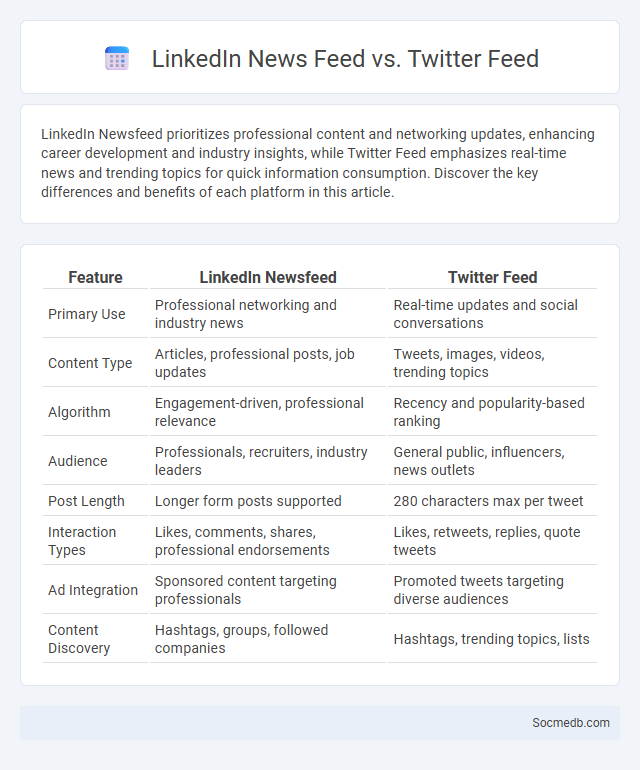
Photo illustration: LinkedIn Newsfeed vs Twitter Feed
LinkedIn Newsfeed prioritizes professional content and networking updates, enhancing career development and industry insights, while Twitter Feed emphasizes real-time news and trending topics for quick information consumption. Discover the key differences and benefits of each platform in this article.
Table of Comparison
| Feature | LinkedIn Newsfeed | Twitter Feed |
|---|---|---|
| Primary Use | Professional networking and industry news | Real-time updates and social conversations |
| Content Type | Articles, professional posts, job updates | Tweets, images, videos, trending topics |
| Algorithm | Engagement-driven, professional relevance | Recency and popularity-based ranking |
| Audience | Professionals, recruiters, industry leaders | General public, influencers, news outlets |
| Post Length | Longer form posts supported | 280 characters max per tweet |
| Interaction Types | Likes, comments, shares, professional endorsements | Likes, retweets, replies, quote tweets |
| Ad Integration | Sponsored content targeting professionals | Promoted tweets targeting diverse audiences |
| Content Discovery | Hashtags, groups, followed companies | Hashtags, trending topics, lists |
Overview: Comparing LinkedIn, Twitter, and Generic Newsfeeds
LinkedIn specializes in professional networking and industry-specific content, offering targeted job opportunities and expert insights. Twitter provides real-time updates and diverse opinions, making it ideal for breaking news and public discourse. Generic newsfeeds aggregate a broad range of topics from multiple sources, emphasizing personalized content through algorithms but often lacking the professional or immediacy focus of LinkedIn and Twitter.
Audience and User Intent Differences
Social media platforms attract diverse audiences with distinct preferences and behaviors, requiring content tailored to varying demographics such as age, interests, and geographic location. Understanding user intent--whether for entertainment, information, networking, or shopping--enables brands to develop targeted strategies that increase engagement and conversion rates. Analyzing metrics like click-through rates, time spent, and interaction patterns helps optimize content relevance and meet specific user goals effectively.
Content Types and Formats
Social media content types include images, videos, stories, reels, and live streams, each designed to engage diverse audience preferences and maximize interaction. High-performing formats such as carousel posts and user-generated content drive higher engagement rates by encouraging user participation and sharing. Optimizing content for platform-specific algorithms, like using vertical videos on TikTok and Instagram Reels, enhances visibility and reach across social media channels.
Algorithm and Feed Personalization
Social media platforms utilize sophisticated algorithms to analyze user behavior, preferences, and interactions, enabling highly personalized content feeds. These algorithms prioritize content based on relevance, engagement metrics, and predicted user interest, enhancing user retention and satisfaction. Continuous machine learning updates refine feed personalization, driving increased time spent on platforms and more targeted advertising opportunities.
Engagement Features and Interactivity
Social media platforms offer a variety of engagement features such as likes, comments, shares, and interactive stories that encourage user participation and foster community building. Interactive tools like polls, quizzes, and live streams boost real-time interaction, increasing your content's visibility and user retention. Leveraging these features effectively enhances audience connection and drives higher engagement metrics across your social channels.
Organic Reach vs. Paid Promotion
Organic reach on social media refers to the number of users who see your content without paid distribution, relying on algorithms that prioritize relevance and engagement. Paid promotion enhances visibility by targeting specific demographics and interests, allowing brands to reach a broader or highly defined audience quickly. Balancing organic reach and paid promotion optimizes overall social media strategy, increasing authentic engagement while driving targeted traffic and growth.
Professional Networking vs. Public Discourse
Professional networking platforms like LinkedIn emphasize career development, industry connections, and skill endorsements, fostering targeted communication among professionals. Public discourse on platforms such as Twitter centers on open dialogue, trending topics, and real-time information exchange, appealing to diverse audiences and facilitating widespread opinion sharing. These distinct social media environments shape user engagement by aligning content with specific goals: career advancement versus public interaction.
News Dissemination Speed and Trends
Social media platforms accelerate news dissemination speed by enabling real-time sharing and viral content distribution, reaching millions within seconds. Algorithms prioritize trending topics, amplifying popular news and shaping public discourse rapidly across diverse demographics. Hashtags and live updates further enhance trend visibility, making social media a critical tool for instantaneous information spread.
Platform-specific Best Practices
Effective social media engagement relies on platform-specific best practices tailored to each network's unique algorithms and user behaviors. Instagram benefits from high-quality visual content, consistent posting schedules, and interactive Stories or Reels to boost user engagement. Twitter demands concise, timely updates with relevant hashtags and real-time interaction, while LinkedIn excels with professional, value-driven content and networking opportunities through groups and articles.
Choosing the Right Feed for Your Goals
Selecting the right social media feed depends on your specific goals, whether it's brand awareness, engagement, or lead generation. For visual storytelling, Instagram's curated feeds or TikTok's algorithm-driven content excel at capturing attention with dynamic posts. Tailoring your strategy to the platform's unique feed structure ensures your content reaches and resonates with your target audience effectively.
 socmedb.com
socmedb.com